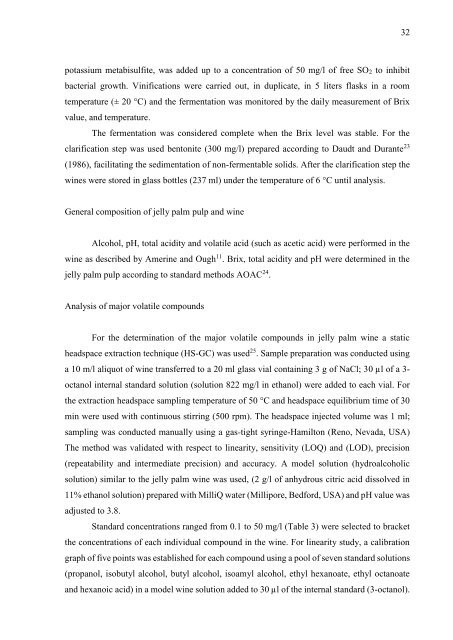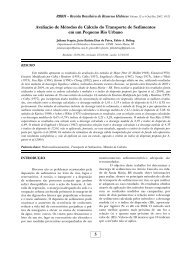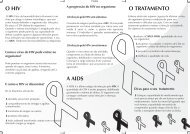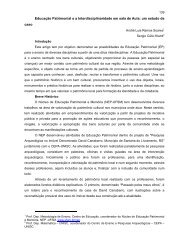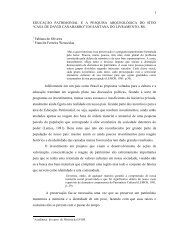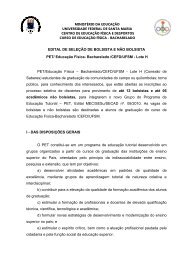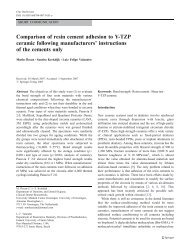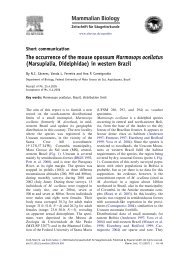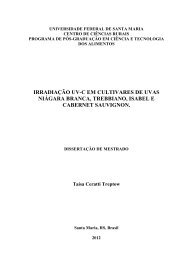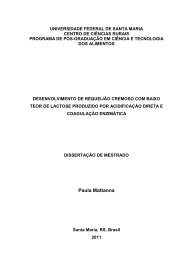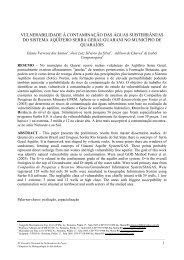DESENVOLVIMENTO E CARACTERIZAÇÃO FÃSICO ... - UFSM
DESENVOLVIMENTO E CARACTERIZAÇÃO FÃSICO ... - UFSM
DESENVOLVIMENTO E CARACTERIZAÇÃO FÃSICO ... - UFSM
You also want an ePaper? Increase the reach of your titles
YUMPU automatically turns print PDFs into web optimized ePapers that Google loves.
32<br />
potassium metabisulfite, was added up to a concentration of 50 mg/l of free SO2 to inhibit<br />
bacterial growth. Vinifications were carried out, in duplicate, in 5 liters flasks in a room<br />
temperature (± 20 °C) and the fermentation was monitored by the daily measurement of Brix<br />
value, and temperature.<br />
The fermentation was considered complete when the Brix level was stable. For the<br />
clarification step was used bentonite (300 mg/l) prepared according to Daudt and Durante 23<br />
(1986), facilitating the sedimentation of non-fermentable solids. After the clarification step the<br />
wines were stored in glass bottles (237 ml) under the temperature of 6 °C until analysis.<br />
General composition of jelly palm pulp and wine<br />
Alcohol, pH, total acidity and volatile acid (such as acetic acid) were performed in the<br />
wine as described by Amerine and Ough 11 . Brix, total acidity and pH were determined in the<br />
jelly palm pulp according to standard methods AOAC 24 .<br />
Analysis of major volatile compounds<br />
For the determination of the major volatile compounds in jelly palm wine a static<br />
headspace extraction technique (HS-GC) was used 25 . Sample preparation was conducted using<br />
a 10 m/l aliquot of wine transferred to a 20 ml glass vial containing 3 g of NaCl; 30 µl of a 3-<br />
octanol internal standard solution (solution 822 mg/l in ethanol) were added to each vial. For<br />
the extraction headspace sampling temperature of 50 °C and headspace equilibrium time of 30<br />
min were used with continuous stirring (500 rpm). The headspace injected volume was 1 ml;<br />
sampling was conducted manually using a gas-tight syringe-Hamilton (Reno, Nevada, USA)<br />
The method was validated with respect to linearity, sensitivity (LOQ) and (LOD), precision<br />
(repeatability and intermediate precision) and accuracy. A model solution (hydroalcoholic<br />
solution) similar to the jelly palm wine was used, (2 g/l of anhydrous citric acid dissolved in<br />
11% ethanol solution) prepared with MilliQ water (Millipore, Bedford, USA) and pH value was<br />
adjusted to 3.8.<br />
Standard concentrations ranged from 0.1 to 50 mg/l (Table 3) were selected to bracket<br />
the concentrations of each individual compound in the wine. For linearity study, a calibration<br />
graph of five points was established for each compound using a pool of seven standard solutions<br />
(propanol, isobutyl alcohol, butyl alcohol, isoamyl alcohol, ethyl hexanoate, ethyl octanoate<br />
and hexanoic acid) in a model wine solution added to 30 µl of the internal standard (3-octanol).


